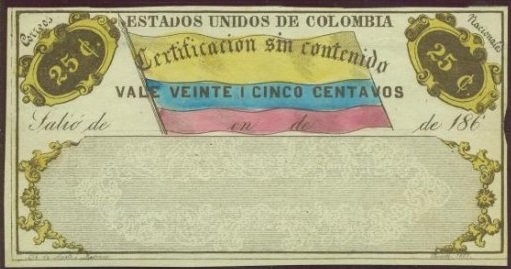Stamp: Flag facing right (Colombia 1865)
Flag facing right (Colombia 1865)
01 January (Colombia ) within release Insured Letter Stamps goes into circulation Stamp Flag facing right face value 25 Colombian centavo
| Stamp Flag facing right in catalogues | |
|---|---|
| Michel: | Mi: CO-WB 1 |
| Yvert et Tellier: | Yt: CO-VR 1 |
| Leo Temprano: | Lt: CO-CUB 1 |
Stamp is horizontal format.
Printed by Lit. Avala y Medrano. Various excellent forgeries exist. Some of them measures 129.5 x 64.5. Variety: black color instead of brown. (YT CO VR1A). The Flagstaff is composed of four lines, two being the outlines, and the other two by way of shading. There is a very small transverse stroke across the flat top of the A of ESTADOS, and a larger and more distinct one over the a of Colombia. The dot over the i of sin is sensibly nearer to the upper outline of the flag than the corresponding dot over the last I of CERTiFiCACioN. Part of the head of the i of contenido, as well as the little oblique stroke projecting from that letter, shows outside the righthand outline of the flag. The hollow centre of the o of cinco is narrower than the hollow portion of the o of CENTAVOS ; and both the said letters are distinctly octagonal in their outline. The central tongue of the e of the latter word is thicker than any of the other strokes forming the back and top and bottom of it. In the inscription salio DE.. EN.. DE.. DE.. 186the accent over the o of salio is perfectly straight, and almost as long as the line projecting from the right-hand side of the o ; and the various words are joined by a thin, but distinct line, which is not dotted anywhere ; the portion of it after 186 goes to the very edge of the boundary-line. The slanting stroke before the e of en does not touch the e ; nor do the similar strokes before the d of the second and third DE touch their respective letters.The 1 of 186 is as tall as the 8,and the 6 touches the corner of the frame above it, which contains 25 c. The point of the flagstaff does not touch the frame above it ; but it is so very close to it that I fancy it might do so in heavily-printed copies. The chief difference between the genuine and the forged is in the shading of the flag. From the lower corner of the yellow part, beginning above the e of vale, there are thirty-two oblicjue lines of shading, the last one ending above the t of certificacion ; none of the long lines pass through the curved head, or the tall thin stroke of the first c of that word, but one of them just touches the top point of it ; two pass through the head of the e, but do not touch it anywhere else. The next lot of shaded lines begins above NT of veinte, and extends to the last i of certificacion. There are thirty-three of them, and none of them touch the line above the T of VEINTE. There are two lines by themselves, above in of veinte, but I have not quoted these, as they are the same as in the forgeries. The next lot of lines begins above the c of centavos, and there are thirty-one of them ; some touching the i of sin, and some touching the first o of contenido. The last lot of lines extends from the middle of the a of centavos in the blue part, right up to the top right-hand corner of the yellow; and there are thirty-three of them. The outline of the flag at the bottom, between the words EN DE, is nearer to the line below it than the corresponding convex portions on each side of en.. de.Also in the issue Insured Letter Stamps:
- Stamp - Flag facing right face value 25;
- Stamp - Flag facing right face value 50;
Stamp Flag facing right it reflects the thematic directions:
A flag is a piece of fabric (most often rectangular or quadrilateral) with a distinctive design that is used as a symbol, as a signaling device, or as decoration. The term flag is also used to refer to the graphic design employed, and flags have since evolved into a general tool for rudimentary signalling and identification, especially in environments where communication is similarly challenging (such as the maritime environment where semaphore is used). National flags are patriotic symbols with varied wide-ranging interpretations, often including strong military associations due to their original and ongoing military uses. Flags are also used in messaging, advertising, or for other decorative purposes. The study of flags is known as vexillology, from the Latin word vexillum, meaning flag or banner.
A number is a mathematical object used to count, measure, and label. The most basic examples are the natural numbers 1, 2, 3, 4, and so forth. Numbers can be represented in language with number words. More universally, individual numbers can be represented by symbols, called numerals; for example, "5" is a numeral that represents the number five. As only a relatively small number of symbols can be memorized, basic numerals are commonly organized in a numeral system, which is an organized way to represent any number. The most common numeral system is the Hindu–Arabic numeral system, which allows for the representation of any non-negative integer using a combination of ten fundamental numeric symbols, called digits. In addition to their use in counting and measuring, numerals are often used for labels (as with telephone numbers), for ordering (as with serial numbers), and for codes (as with ISBNs). In common usage, a numeral is not clearly distinguished from the number that it represents.


